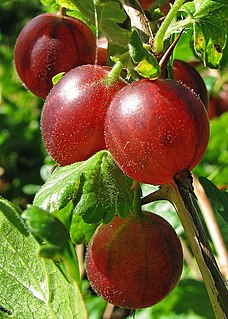
Gooseberry, is a common name for many species of Ribes and other species of plants. The berries of those in the genus Ribes are edible and may be green, red, purple, yellow, white, or black.
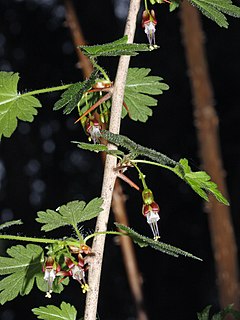
Ribes is a genus of about 200 known species of flowering plants native throughout the temperate regions of the Northern Hemisphere. The various species are known as currants or gooseberries, and some are cultivated for their edible fruit or as ornamental plants. Ribes is the only genus in the family Grossulariaceae.

The redcurrant, or red currant is a member of the genus Ribes in the gooseberry family. It is native across Europe. The species is widely cultivated and has escaped into the wild in many regions.
Red currant may refer to:

Ribes uva-crispa, known as gooseberry or European gooseberry, is a species of flowering shrub in the currant family, Grossulariaceae. It is native to Europe, the Caucasus and northern Africa. Gooseberry bushes produce an edible fruit and are grown on both a commercial and domestic basis. Its native distribution is unclear, since it may have escaped from cultivation and become naturalized. For example, in Britain, some sources consider it to be a native, others to be an introduction. The species is also occasionally naturalized in scattered locations in North America.

Ribes sanguineum, the flowering currant, redflower currant, red-flowering currant, or red currant is a North American species of flowering plant in the family Grossulariaceae, native to western United States and Canada, but widely cultivated and naturalized throughout temperate Europe and Australasia.

Littorina sitkana is a species of small sea snail, a marine gastropod mollusc in the family Littorinidae, the winkles. It is commonly found in the high tidal zone and the splash zone.

Ribes aureum, known by the common names golden currant, clove currant, pruterberry and buffalo currant, is a species in the genus Ribes. It is native to Canada, most of the United States and northern Mexico. The variety Ribes aureum var. villosum is sometimes considered a full species, Ribes odoratum.

The saguaro is a tree-like cactus species in the monotypic genus Carnegiea, that can grow to be over 12 meters tall. It is native to the Sonoran Desert in Arizona, the Mexican state of Sonora, and the Whipple Mountains and Imperial County areas of California. The saguaro blossom is the state wildflower of Arizona. Its scientific name is given in honor of Andrew Carnegie. In 1994, Saguaro National Park, near Tucson, Arizona, was designated to help protect this species and its habitat.

Ribes divaricatum is a species in the genus Ribes found in the forests, woodlands, and coastal scrub of western North America from British Columbia to California. The three accepted varieties have various common names which include the word "gooseberry".
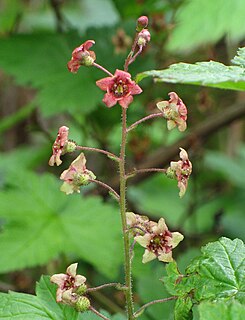
Ribes laxiflorum is a species of currant known by the common names trailing black currant, and spreading currant. It is native to western North America from Alaska and Yukon south as far as northern California and New Mexico; it has also been found in Siberia. Its habitat includes moist mountain forests, open clearings, streambanks, and the borders of mountain roads.

Ribes montigenum is a species of currant known by the common names mountain gooseberry, alpine prickly currant, western prickly gooseberry,and gooseberry currant. It is native to western North America from Washington south to California and east as far as the Rocky Mountains, where it grows in high mountain habitat types in subalpine and alpine climates, such as forests and talus. It is a spreading shrub growing up to 1.5 meters tall, the branching stems covered in prickles and hairs and bearing 1 to 5 sharp spines at intervals.
Ribes nevadense is a species of currant known by the common names Sierra currant and mountain pink currant.

Ribes thacherianum, with the common name Santa Cruz gooseberry, or Santa Cruz Island gooseberry, is a rare North American species of currant found only on one island off the coast of California.
Fuchsia-flowered gooseberry is a common name for two gooseberry species with showy flowers native to western North America:
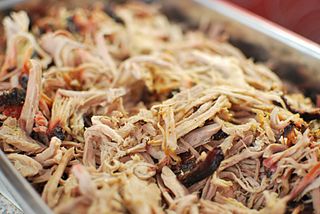
Barbecue is an important part of the heritage and history of the U.S. state of North Carolina. It has resulted in a series of bills and laws that relate to the subject, and at times has been a politically charged subject. In part, this is due to the existence of two distinct types of barbecue that have developed over the last few hundred years: Lexington style and Eastern style. Both are pork-based barbecues but differ in the cuts of pork used and the sauces they are served with. In addition to the two native varieties, other styles of barbecue can be found throughout the state.

Ribes americanum is a North American species of flowering plant in the gooseberry family known as wild black currant, American black currant, and eastern black currant. It is widespread in much of Canada and the northern United States.
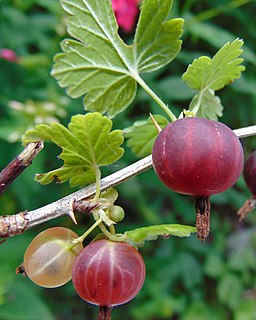
Ribes hirtellum is a species of gooseberry commonly known as wild gooseberry or swamp gooseberry. It is native to Canada and the northern United States. Cultivated gooseberries are derived from this species and from Ribes uva-crispa.

Ribes cynosbati is a North American species of shrub in the family Grossulariaceae. It is native to the eastern and central United States and Canada. It has several common names, including prickly gooseberry, eastern prickly gooseberry, dogberry, and dog bramble. It grows in rich forests, rocky slopes, and open heaths from New Brunswick south along the Appalachian Mountains to northern Alabama and west as far as Manitoba, the Dakotas and Oklahoma.














